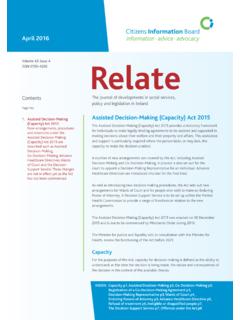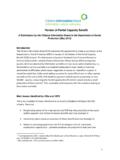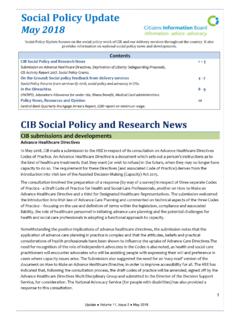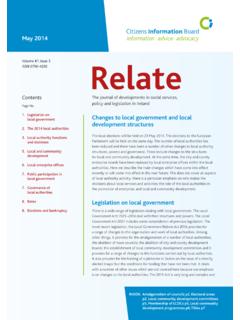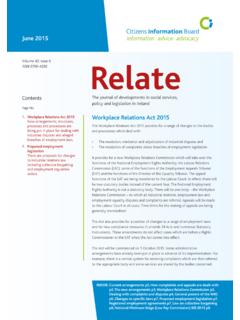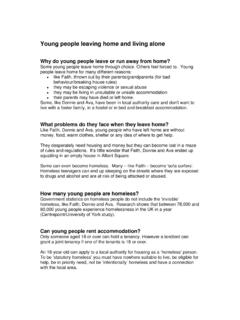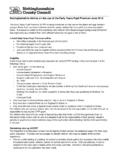Transcription of Working Family Payment Submission by the Citizens ...
1 Working Family Payment Submission by the Citizens information board ( march 2017 ). Introduction The Citizens information board (CIB) welcomes the opportunity to make a Submission to the Department of Social Protection (DSP) in respect of the Working Family Payment . The Submission is based primarily on feedback from Citizens information Services (CISs) and the Citizens information Phone Service (CIPS) arising from queries from people seeking to transition from welfare to There continue to be people in the social welfare system who have difficulty making the transition to work. In this regard, it will be necessary to look in more detail at the purpose of the Working Family Payment , , whether it is seen as addressing in-work poverty or improving financial incentives to work, or both. A key question which needs to be asked is whether or not there is a significant group of people for whom the availability of a Working Family Payment would make a difference.
2 An obvious matter to be addressed is how the proposed Working Family Payment would differ from and/or be integrated with Family income Supplement (FIS). The promotion of work over welfare through the greater incentivising of work is important for social and economic reasons building on the lessons learned from the various work activation and employment support programmes put in place over the years. While the decision to develop a Working Family Payment is welcome, its success or otherwise will be determined to a large extent by its design. Crucial in this regard will be flexibility and clear, accessible and fluent administrative pathways. The experience of delivering FIS will be most valuable in this regard. While the proposed Working Family Payment should be underpinned by the notion of making work pay, it is less clear how it will address endemic issues of in-work poverty, income inequality and child poverty.
3 Also, the impact of social transfers in alleviating income poverty in Ireland will remain a crucial consideration. The implications of any scheme for different groups would depend on the design of the scheme, , lone parents, second earners in married/cohabiting couples due to assessment of income at household level. Relevant factors In introducing a Working Family Payment , there are a number of relevant considerations: How to integrate a Working Family Payment into the overall welfare and taxation system, including, in particular, FIS and the Back to Work Family Dividend The need to link the Working Family Payment with minimum wage and living wage considerations The need to cater for short-term and long-term unemployment, part-time, casual and atypical Working 1. Citizens information Services dealt with over a million queries in 2016, 46% of which were social welfare related. These included almost 60,000 jobseeker Payment queries; 26,865 FIS queries and a further 15,000.
4 Activation scheme queries. 1. Identifying and addressing the risk factors for in-work poverty The need to identify and examine in greater detail broader issues which affect people's decisions on whether or not to work (and for how many hours), , the impact of replacement rates on people's decision to take up work or not Replacement Rates The replacement rate is the most commonly used single measure of the incentive to be in employment. It measures the proportion of in-work income which would be retained or replaced ( , by jobseeker payments) when out of work. Since the Working Family Payment would be aimed primarily at making work more financially attractive, the matter of replacement rates must be taken fully into account. ESRI2 data shows that almost one-fifth ( ) of unemployed people have a replacement rate of more than 70 per cent, while 11% have a replacement rate of more than 80 per cent.
5 However, it is also the case that almost 80% of unemployed individuals have a replacement rate of less than 70 per These individuals would see their incomes rise by at least 43% if they were to obtain a job, at a wage corresponding to their qualifications. The ESRI has identified the causes of high replacement rates as: Payment of rent supplement4; Payment of qualified adult and qualified child increases. In introducing the Working Family Payment , it would be useful to have more detailed evidence as to the precise breakdown of those requiring additional financial incentives to work and also more data as to how and why people make decisions concerning taking up employment (and how this may differ for different groups). There are also potential issues concerning administration and take-up which would need to be identified and addressed. The experience of the FIS scheme and factors influencing decisions on uptake can and should inform deliberations around the establishment of the Working Family Payment .
6 Welfare to Work: Ongoing Barriers and Difficulties5. In addition to the question of replacement rates, there a number of factors which are likely to impact on the operation of the Working Family Payment . These have been well documented over the years and can be summarised as: childcare costs; housing costs;. having a Medical Card; transport costs (in rural areas); and eligibility for Student Grants. An additional difficulty that has been regularly highlighted relates to transitioning between temporary and part-time work and jobseekers' payments and the fact that in such circumstances, people on the minimum wage may be only marginally better off. Ongoing problems relating to the administration of FIS that may be relevant to the Working Family Payment The experience of FIS can inform in a significant manner the way the Working Family Payment could be structured and administered. Despite the increased expenditure on FIS.
7 2. 3. Each figure represents the proportion of the population with a replacement rate above a particular value; as they are cumulative totals, the figures are not additive. (ESRI). 4. The new Housing Assistance Payment addresses this. 5. Some illustrative examples of the difficulties reported are included in an Appendix. 2. during 2016, issues reported by CISs and CIPS point to a need for further FIS reform. The following aspects of the scheme are identified as having a negative impact on FIS take-up: The level at which both the income limits and the Working hours threshold is set is not seen to be reflective of the Working reality for many people for instance, people who are Working on low pay, zero hours contracts, if and when work patterns and seasonal work;. The amount of FIS is usually established for 52 weeks ahead if a person's wages are reduced during that time, the FIS Payment will stay the same.
8 If the number of hours a person works each week is reduced to below 38 hours per fortnight, s/he is no longer entitled to FIS;. The prospect of the immediate withdrawal of FIS on loss of a job or reduced Working hours can impact on people taking up precarious employment;. A significant issue identified is the exclusion of CE and T S participants from FIS;. Since FIS also acts as a gateway Payment to the Back to School Clothing and Footwear Allowance, non-eligibility for FIS may impact on work take-up;. FIS does not apply to self-employed people and there are delays reported in relation to spouses of self-employed people being able to establish eligibility for FIS;. Some people taking up employment of 3 days a week may be better off claiming Jobseekers Allowance for 2 days instead of FIS;. The FIS income limits do not take sufficient account of housing costs;. Some families are reported as not taking up FIS on the basis that applications are taking too long to process and a fear that they may have to live on significantly reduced income for a non-defined period the time frame for processing FIS.
9 Applications can be up to 4 months. Other Issues There are a number of issues that have been identified by CISs and CIPS as impacting on people taking up low paid employment and seeking supports: People returning to casual work and who are on flexi dockets are being paid in arrears and can be left without adequate income for daily living;. If both members of a couple are signing on for Jobseekers Allowance, both have to come off the live register in order to apply for the Back to Work Family Dividend . this may mean that one partner is no longer in the system with potential consequences for pension entitlement or social welfare payments in the future;. 3. The means tests for the various supports can be very confusing and hard for people to determine, , do they go for FIS and the Back to Work Family Dividend or one of the couple claim FIS and the other stay on means-tested JA;. A person on JA who gets casual hours employment has his/her JA claim moved from being paid in advance to been paid in arrears, which results in a week without Payment .
10 Need for the public to be well informed about employment supports The following have been identified by CISs and CIPS as areas where the public are not well informed and which, therefore, may have a bearing on whether or not they take up work. Many people appear to be unaware that they can retain their Medical Card for three years on taking up employment;. There appears to be a low level of awareness of the new Back to Work Family Dividend;. Not all families are aware that couples can combine hours to establish FIS eligibility;. Some single/separated parents are not aware they can claim FIS once they can prove they are paying maintenance;. There is an under-awareness of home carers tax credits, bereavement and incapacitated child tax credits;. Tax incentives and tax implications of work are not widely known or understood. CISs have noted that some people do not ask about entitlements because of fear that it may impact on their existing social welfare payments.
